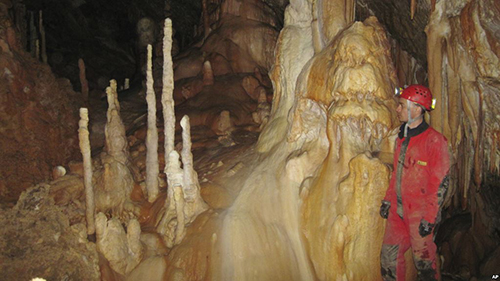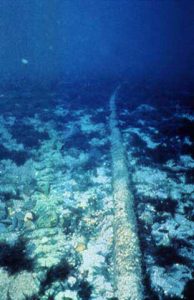
By Jim Brace-Thompson
Cave Deposits Hint at Happenings of Neanderthals
Speleothems are limestone or dolostone deposits in caves (think of stalactites and stalagmites). They form when minerals in solution slowly accrete as groundwater drips through caves, building a record similar to tree rings. Close analysis of mineral layers in a speleothem can reveal details about ancient climates.
After analyzing the record left in Ascunsa Cave in Romania, scientists released a study on August 27 suggesting that speleothems offer evidence of two major climate shifts in Europe 44,000 and 40,000 years ago, which coincides with the period when modern humans replaced Neanderthals. Their findings support prior archeological evidence suggesting that climate change resulted in shrub-filled grasslands replacing forests across Europe during that time period and suggesting that Homo sapiens were better adapted to the new conditions than were Neanderthals.
Get the scoop about the latest rock, gem, and mineral features and news, rock shop and rockhound profiles, and exclusive freebies and promotions in your inbox. >>>
Seeking New Earths
Earlier this year, NASA launched the Transiting Exoplanet Survey Satellite (TESS), and we will soon see its first results as it scans the stars in search of planets and reports back approximately every two weeks.
While the search for new planets is all the rage among astronomers nowadays, TESS could set a whole new standard, with excitement building that it may yield literally thousands of planets as it monitors stars nearest to Earth.
Says, Paul Hertz of NASA, “I look forward to the strange, fantastic worlds we’re bound to discover.”
Detecting Earthquakes on the Ocean Floor

While installing earthquake sensors is relatively easy on dry land, most of the Earth’s surface is under oceans. Without a system of sensors, how might we detect and gauge earthquakes under water that could result in tsunamis or damage from shaking on dry land?
Per the August 3 issue of the journal Science, one group of researchers has detected seismic waves via existing underwater fiber optic cables being used for telecommunications. Laser lights sent through such cables have shown effectiveness in detecting even very small strain changes, such as those caused by seismic waves.
So it would seem to turn out that we’ve already populated our ocean floors with seismic sensors after all. We just needed to learn how to read them!
Author: Jim Brace-Thompson
 Founder and overseer of the AFMS Badge Program for kids.
Founder and overseer of the AFMS Badge Program for kids.
He’s also an inductee of the National Rockhound & Lapidary Hall of Fame within the Education Category.












